Pinpointing Moisture: The Capacitive Detection for Standing Tree Health
Abstract
1. Introduction
2. Materials and Methods
2.1. Instrument Design
2.2. Measuring Standing Tree Area
2.3. Instrument Verification
2.4. Instrument Calibration
3. Results
3.1. Wood Media Test
3.2. Field Test Validation
4. Discussion
5. Conclusions
- The equipment is optimized from both hardware and software aspects. Due to the good conductivity of purple copper, it is chosen as the probe material, which can better retain the integrity of an electrical signal; the microcontroller judges pulse the trailing edge to determine that the frequency is stable and reliable; and the 555 timing circuit has high sensitivity to capacitance changes. The software structure is optimized in terms of sampling, especially software filtering, which reduces the occurrence of accidental errors and improves accuracy of data.
- Pretests on distilled water prior to laboratory testing of moisture content of live tree trunks showed that the electromagnetic wave period gradually increased with the increase in insertion depth, i.e., the increase in moisture, and the goodness of fit was 0.99, indicating that the meter has excellent sensitivity to water.
- The field and indoor tests showed that applicability of the moisture content meter for standing tree trunks was verified by constructing mathematical models for different tree species. The instrument is capable of measuring moisture content of basswood and fir tree trunks in the range of 0 to 180%, with a wide range of measurements. The average error of measurement was 7.75% for basswood and 7.35% for fir, both within 8%. Overall, the design and measurement results of the instrument were satisfactory.
Author Contributions
Funding
Institutional Review Board Statement
Informed Consent Statement
Data Availability Statement
Conflicts of Interest
References
- Nelson, S.O. Use of electrical properties of grain-moisture measurement. J. Microw. Power 1977, 12, 67–72. [Google Scholar] [CrossRef]
- Hammer, E.A.; Tollefsen, J.; Olsvik, K. Capacitance transducers for non-intrusive measurement of water in crude oil. Flow Meas. Instrum. 1989, 1, 51–58. [Google Scholar] [CrossRef]
- Schuller, R.B.; Gundersen, T.; Halleraker, M.; Engebretsen, B. Measurement of water concentration in oil/water dispersions with a circular single-electrode capacitance probe. IEEE Trans. Instrum. Meas. 2004, 53, 1378–1383. [Google Scholar] [CrossRef]
- Eller, H.; Denoth, A. A capacitive soil moisture sensor. J. Hydrol. 1996, 185, 137–146. [Google Scholar] [CrossRef]
- Liu, S.; An, J.; Luo, Y.; Ge, Y.; Wang, J.; Wang, S. Mathematical model and finite element solution of single plane capacitive sensor. J. Harbin Eng. Univ. 2011, 32, 79–84. [Google Scholar]
- Kong, L. Research on Wood Moisture Content Detection System Based on Forked-Finger Capacitive Sensor. Master’s Thesis, Harbin Engineering University, Harbin, China, 2016. [Google Scholar]
- Liu, S.; Li, F.; Zhao, D.; Li, S.; Gu, Q.; Zhou, Z. Design of micro-capacitor detection system based on AD7746. Appl. Sci. Technol. 2011, 38, 1–5. [Google Scholar]
- Guo, C. Mathematical Model of Capacitive Sensor and Its Algorithm for Detecting Moisture Content of Wood. Ph.D. Thesis, Harbin Engineering University, Harbin, China, 2014. [Google Scholar]
- Matheny, A.M.; Garrity, S.R.; Bohrer, G. The Calibration and Use of Capacitance Sensors to Monitor Stem Water Content in Trees. J. Vis. Exp. JoVE 2017, 130, e57062. [Google Scholar]
- Vu, T.H.T.; Tetsuya, I.; Satoru, T. A new approach based on a combination of capacitance and near-infrared spectroscopy for estimating the moisture content of timber. Wood Sci. Technol. 2019, 53, 579–599. [Google Scholar]
- Lev, J.; Křepčík, V.; Šarauskis, E.; Kumhála, F. Electrical Capacitance Characteristics of Wood Chips at Low Frequency Ranges: A Cheap Tool for Quality Assessment. Sensors 2021, 21, 3494. [Google Scholar] [CrossRef]
- Oskouei, F.J.; Masoudi, A.A.; Khorrami, M. The static and dynamic behavior of a simple parallel-plate capacitor with Casimir force. Chaos Solitons Fractals Interdiscip. J. Nonlinear Sci. Nonequilibrium Complex Phenom. 2021, 150, 111199. [Google Scholar] [CrossRef]
- Grove, T.T.; Masters, M.F.; Miers, R.E. Determining dielectric constants using a parallel plate capacitor. Am. J. Phys. 2005, 73, 52–56. [Google Scholar] [CrossRef]
- AN170. NE555 and NE556 Applications; Integrated Circuits; Philips Semiconductors: Eindhoven, The Netherlands, 1988.
- Drevinskas, T.; Kaljurand, M.; Maruška, A. Capacitance-to-digital: A single chip detector for capillary electrophoresis. Electrophoresis 2014, 35, 2401–2407. [Google Scholar] [CrossRef] [PubMed]
- Lee, K.; Shur, M.S.; Drummond, T.J.; Morkoc, H. Current—Voltage and capacitance—Voltage characteristics of modulation-doped field-effect transistors. IEEE Trans. Electron. Devices 1983, 30, 207–212. [Google Scholar]
- Chen, T.S. Determination of the capacitance, inductance, and characteristic impedance of rectangular lines. IRE Trans. Microw. Theory Tech. 1960, 8, 510–519. [Google Scholar] [CrossRef]
- Saha, R.; Biswas, S.; Sarmah, S.; Karmakar, S.; Das, P. A Working Prototype Using DS18B20 Temperature Sensor and Arduino for Health Monitoring. SN Comput. Sci. 2021, 2, 33. [Google Scholar]
- Xu, Q.; Xu, H.; Di, Y.; Li, Q. Effect of probe insertion depth on the accuracy of inversion of water content of birch trunks by time-domain reflection method. J. For. Eng. 2019, 4, 120–126. [Google Scholar]
- Wang, Y.; Xu, H.; Zhou, H.; Cao, Y.; Ji, L. Effect of ambient temperature on the change of internal moisture content of standing trees. J. Nanjing For. Univ. Nat. Sci. Ed. 2017, 41, 107–113. [Google Scholar]
- Korkua, S.K.; Sakphrom, S. Low-cost capacitive sensor for detecting palm-wood moisture content in real-time. Heliyon 2020, 6, e04555. [Google Scholar] [CrossRef]
- Chetpattananondh, P.; Thongpull, K.; Chetpattananondh, K. Interdigital capacitance sensing of moisture content in rubber wood. Comput. Electron. Agric. 2017, 142, 545–551. [Google Scholar] [CrossRef]
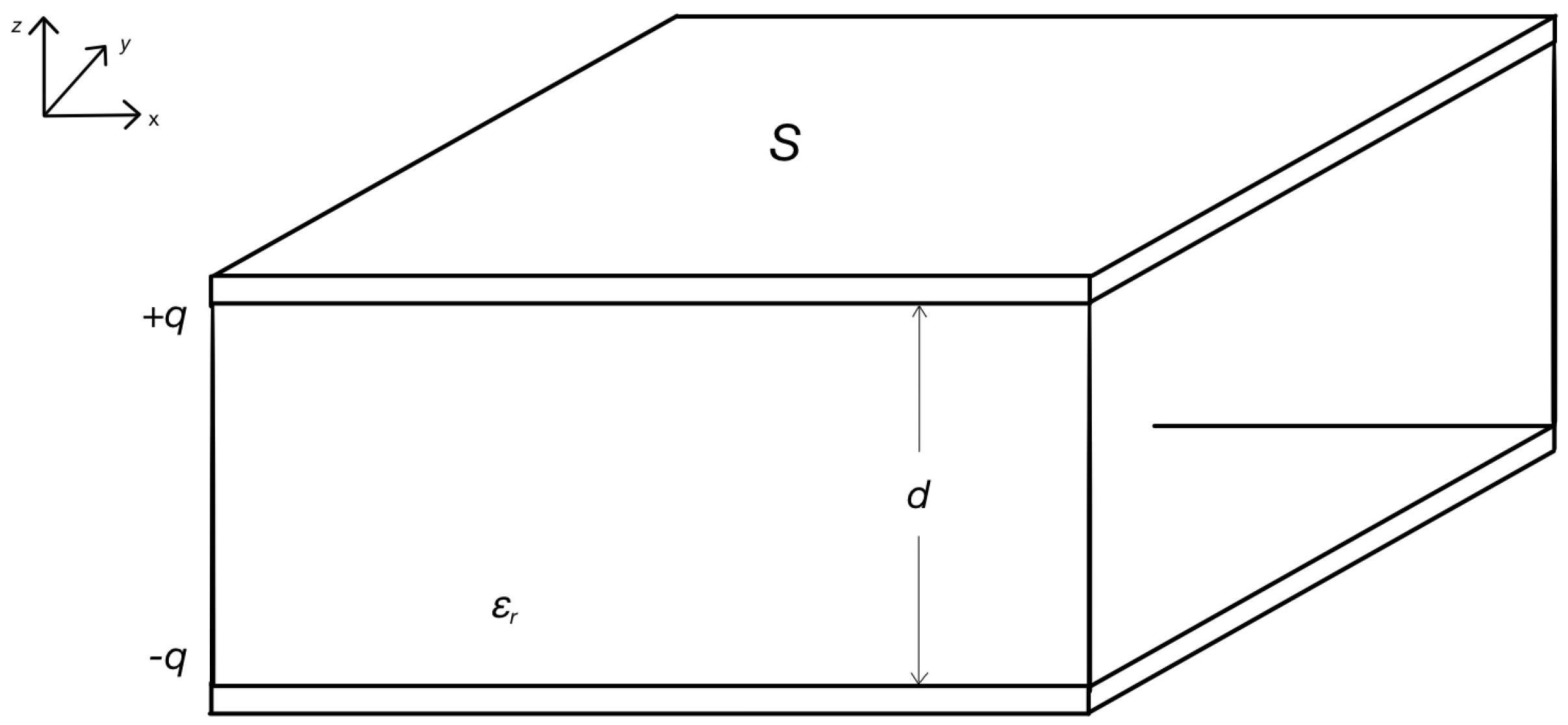

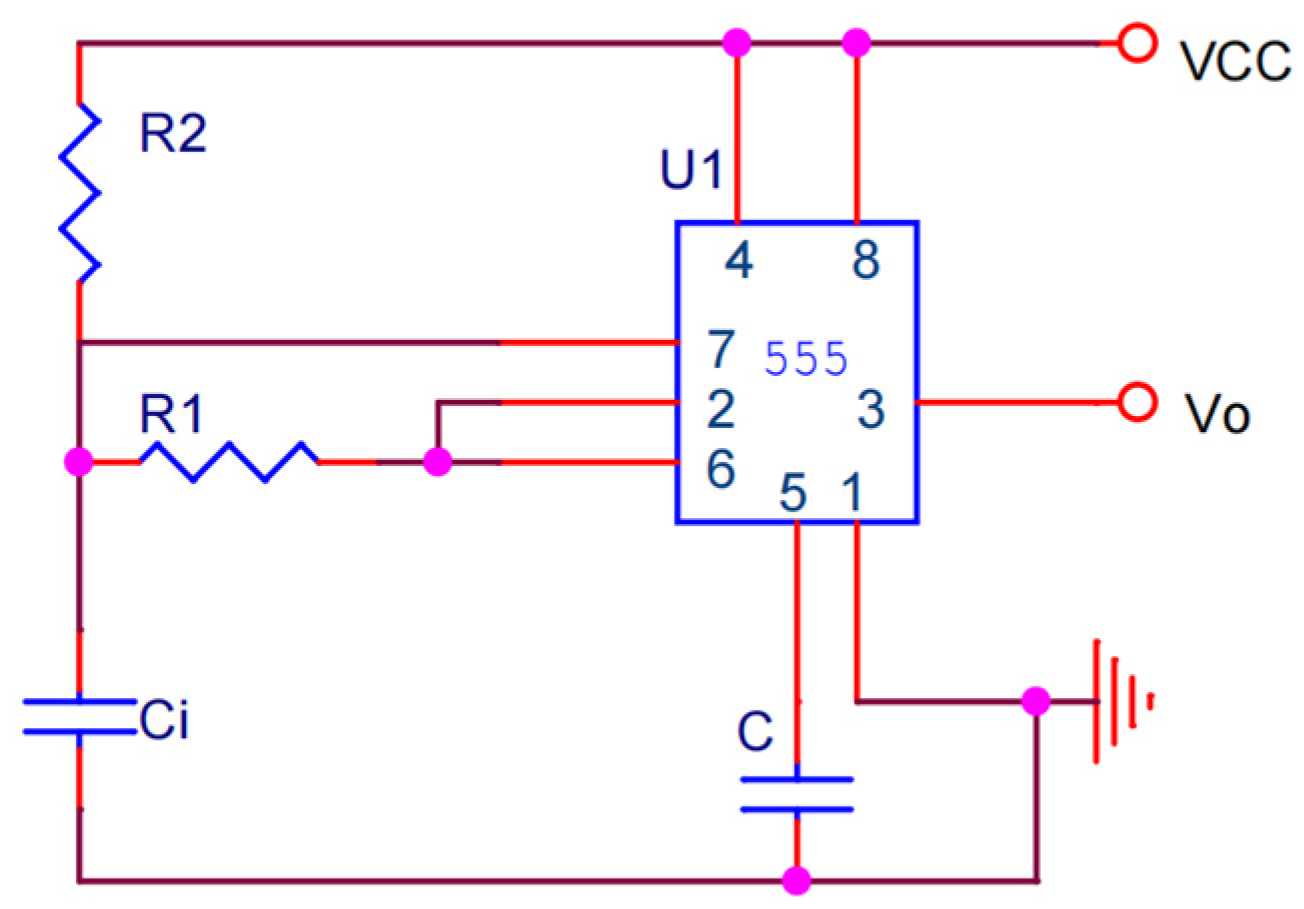

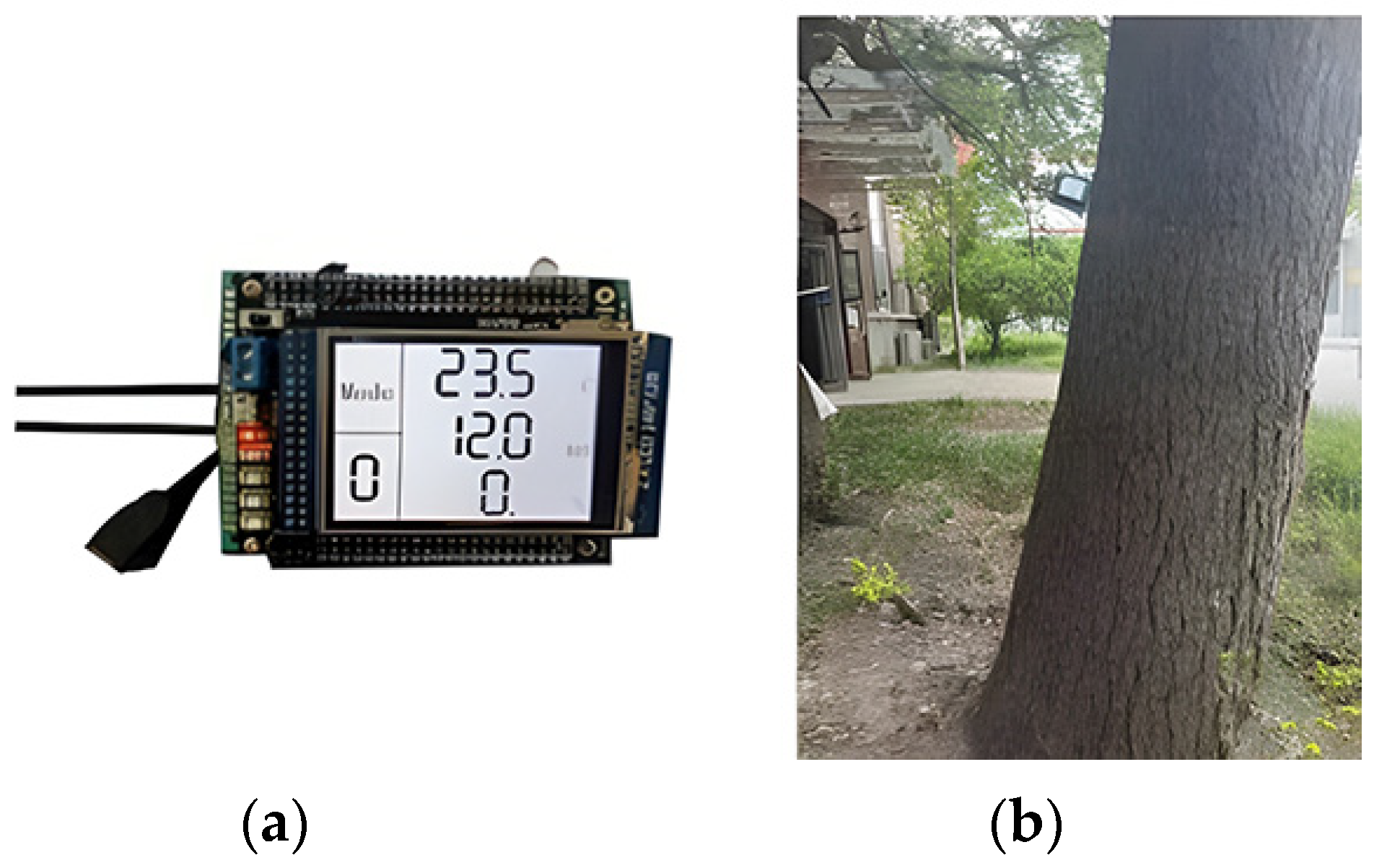
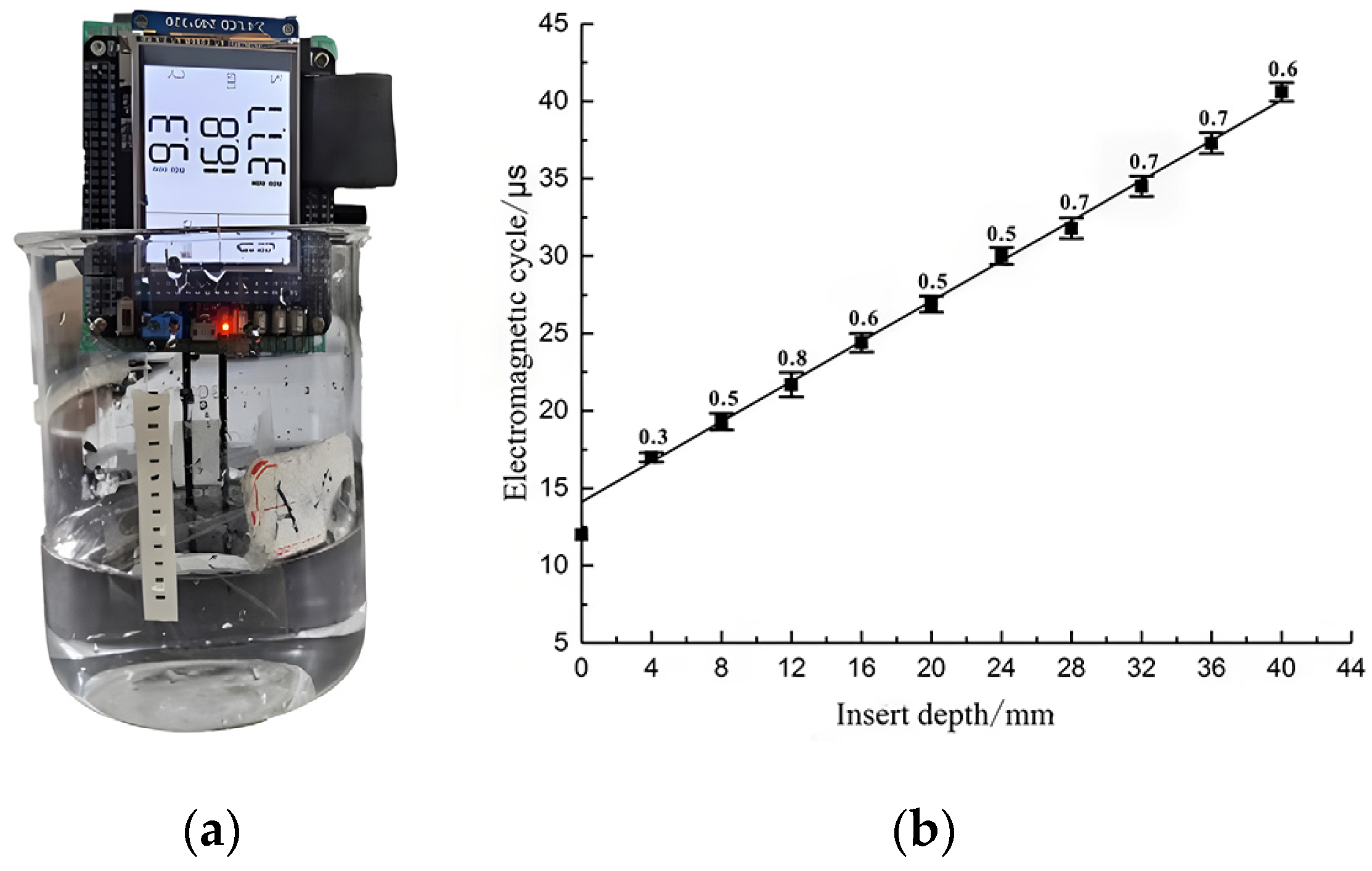
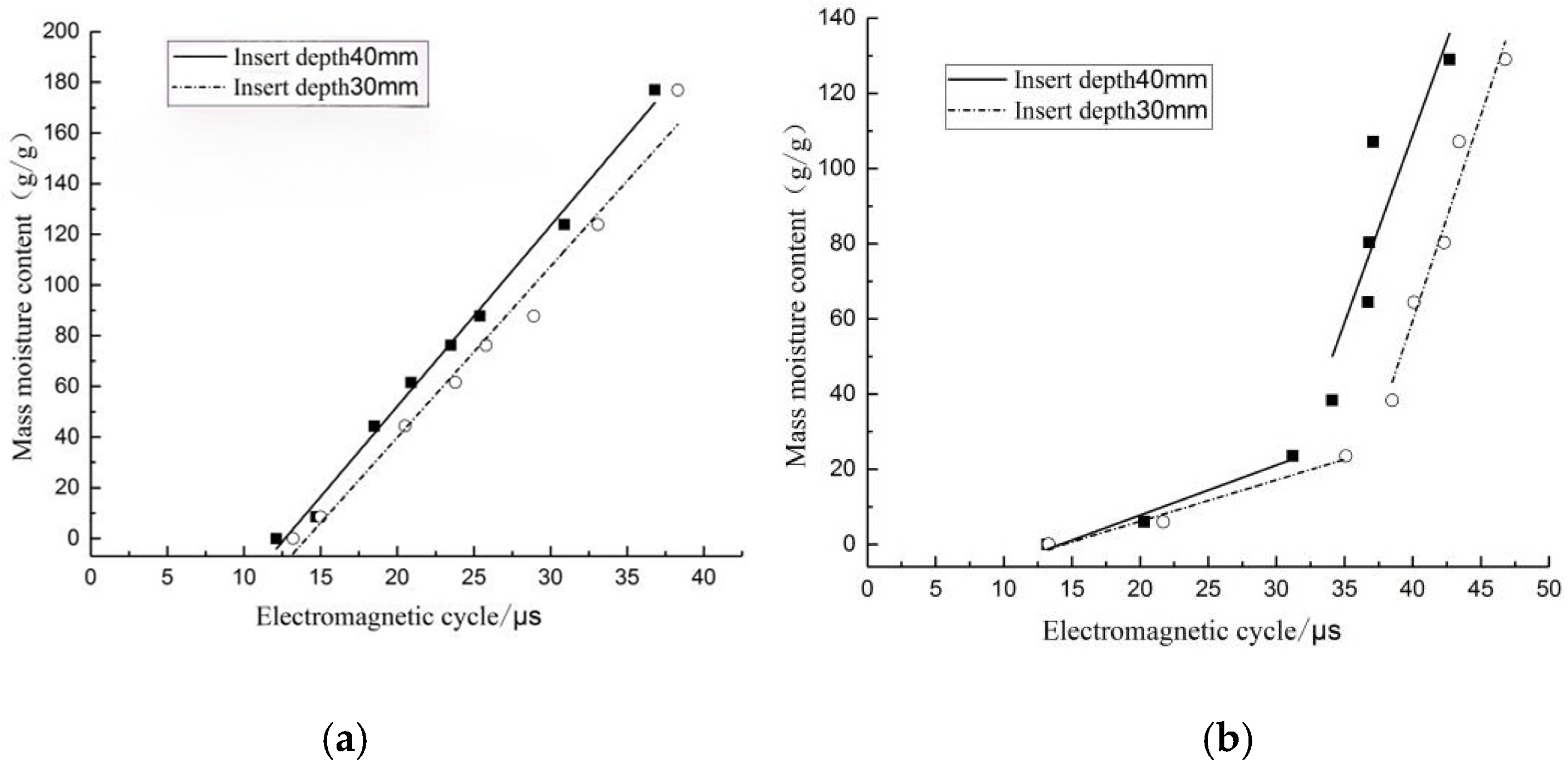


| Tree Species | Insert Depth | Fitting Equation | R2 | ||
|---|---|---|---|---|---|
| Basswood | 30 mm | y = 6.75x − 95.10 | 0.98 | ||
| 40 mm | y = 7.13x − 90.39 | 0.99 | |||
| Fir | Moisture content is less than 30% | Moisture content is more than 30% | R12 | R22 | |
| 30 mm | y = 1.10x − 15.85 | y = 10.92x − 377.31 | 0.98 | 0.96 | |
| 40 mm | y = 1.33x − 18.87 | y = 9.99x − 290.52 | 0.98 | 0.79 | |
| Tree Species | Insert Depth | Processing Method | Fitting Equation | R2 | ||
|---|---|---|---|---|---|---|
| Bass wood | 40 mm | Drying method | y = 5.27x − 46.90 | 0.81 | ||
| Capacitance method | y = 6.33x − 74.50 | 0.87 | ||||
| Moisture content is less than 30% | Moisture content is more than 30% | R12 | R22 | |||
| Fir | 30 mm | Drying method | y = 3.40x − 84.34 | y = 9.03x − 250.87 | 0.98 | 0.96 |
| Capacitance method | y = 2.00x − 39.29 | y = 9.73x − 282.78 | 0.99 | 0.98 | ||
Disclaimer/Publisher’s Note: The statements, opinions and data contained in all publications are solely those of the individual author(s) and contributor(s) and not of MDPI and/or the editor(s). MDPI and/or the editor(s) disclaim responsibility for any injury to people or property resulting from any ideas, methods, instructions or products referred to in the content. |
© 2024 by the authors. Licensee MDPI, Basel, Switzerland. This article is an open access article distributed under the terms and conditions of the Creative Commons Attribution (CC BY) license (https://creativecommons.org/licenses/by/4.0/).
Share and Cite
Yao, J.; Zhen, Z.; Xu, H.; Zhao, L.; Duan, Y.; Guo, X. Pinpointing Moisture: The Capacitive Detection for Standing Tree Health. Sensors 2024, 24, 4040. https://doi.org/10.3390/s24134040
Yao J, Zhen Z, Xu H, Zhao L, Duan Y, Guo X. Pinpointing Moisture: The Capacitive Detection for Standing Tree Health. Sensors. 2024; 24(13):4040. https://doi.org/10.3390/s24134040
Chicago/Turabian StyleYao, Jianan, Zonglin Zhen, Huadong Xu, Liming Zhao, Yuying Duan, and Xuhui Guo. 2024. "Pinpointing Moisture: The Capacitive Detection for Standing Tree Health" Sensors 24, no. 13: 4040. https://doi.org/10.3390/s24134040
APA StyleYao, J., Zhen, Z., Xu, H., Zhao, L., Duan, Y., & Guo, X. (2024). Pinpointing Moisture: The Capacitive Detection for Standing Tree Health. Sensors, 24(13), 4040. https://doi.org/10.3390/s24134040





